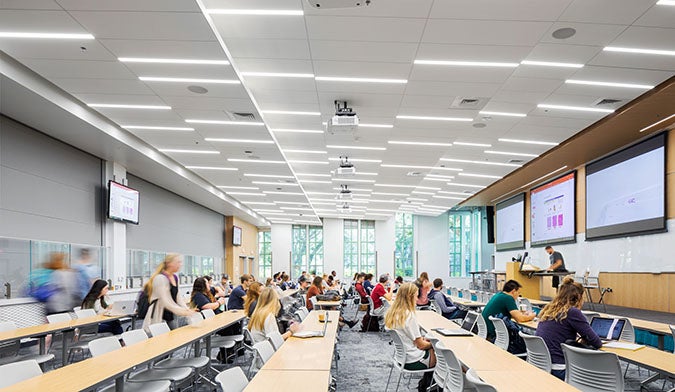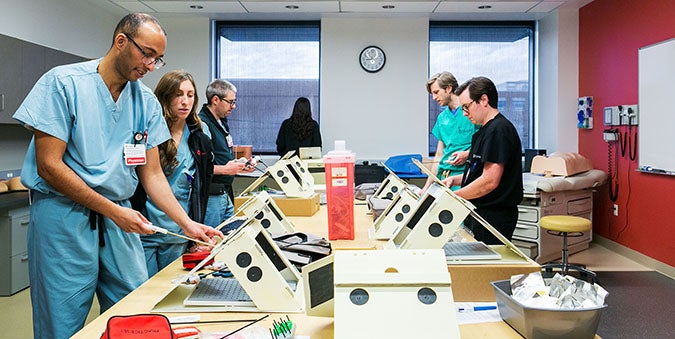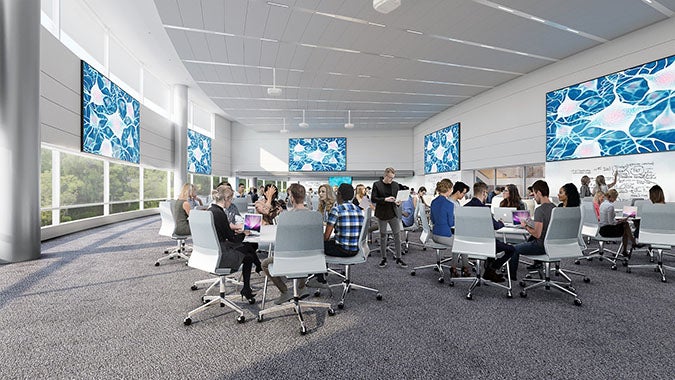
Designing for Health Sciences Education: Lecture Halls and Classrooms for the Future
This is the third article in six-part Designing for Health Sciences Education series.
“We will not succeed in navigating the complex environment of the future by peering relentlessly into a rearview mirror. To stay on this course, we should be out of our minds.”
This quote, from Sir Ken Robinson, in his foreword to Out of Our Minds1, speaks to the necessity of not getting “stuck” in our old ways. It is particularly apt when we think about the spaces that will facilitate the best health sciences educational experiences moving forward.
In the past two articles, we’ve taken a closer look at the students that are entering health sciences education today and the faculty that are teaching them. We have talked about how students learn effectively. We’ve explored nursing and medical education during the first two decades of the 21st century. But what does this mean for space and how it facilitates the best learning and teaching experience?
The next articles in this series will focus on this question, with this article looking specifically at how lecture halls and classrooms need to evolve to meet the demands of today’s students and the evolution of medical and nursing education. Going forward, health sciences schools need to take a hard look at the facilities they have for teaching and learning and make some hard (sometimes costly) decisions about their portfolio of spaces and what will provide the most value for their students and their legacies.
The Lecture Hall of Old
The classroom spaces needed today for active learning, both large and small, are generally quite different than those that have typically been in the space portfolios of U.S. health science schools. Historically, the method of delivering content was typically within a large lecture hall, where students sat theatre-style, took notes by hand, and were introduced to the content for the first time. In many medical schools, four identical lecture halls each housed one entire cohort — often steeply tiered, with students facing forward and with little opportunity to interact with each other. Smaller classrooms that were geared toward advanced electives were limited and the ones that were available had to compete with administrative meetings. Students studied mostly at home or in libraries, memorising vast amounts of information. Nursing students followed this basic method as well.
Campus leadership needs to actively look at how their most valuable real estate is being used and assess whether it is beneficial to swap these large lecture spaces for new-sized spaces, active learning classrooms or other needs. A fresh look at these inflexible spaces also provides opportunities to create more sustainable, environmentally conscious spaces or buildings. In one interaction with a campus that had four identical lecture halls in the middle of the complex, it was found that a 180-seat room was generally only occupied by 20 or 30 people. Leadership was initially stubborn on the need for those spaces, but later realised that the real need was for spaces of 30-50 people, as those were lacking and the lecture halls were being used in their stead.
There are two problems with this type of thinking. First, for a learning space to “feel” successful, it needs to be full. Sitting in a cavernous space with only a few other students feels psychologically like “Where is everybody. Why are there only a few of us?. Second, when large numbers of seats are unused in a space which is heated, cooled, and taking up valuable real estate, that is space which is wasted over the very long life of the facility.
Lecture Halls and Classrooms for Modern Health Sciences
Today, healthcare has become increasingly patient-focused, and the education of various healthcare providers is increasingly intertwined, with emphasis on interprofessional education. However, educational institutions are often without appropriate space to facilitate IPE activities. These challenges are further coloured by the recent pandemic, which has brought forward different standards for active learning and spacing. As medical, nursing and allied health schools continue to modernise their curricula to reflect today’s methods, ideal learning environments typically require a mix of large and small classrooms that accommodate flexible furniture arrangements conducive to both instructor-led lecture and small group discussion.

Flat-Floor Lecture Halls
It is still beneficial to have a place where all the students in the class can take instruction together. Indeed, today’s multi-device, tech-savvy Generation Z has expressed their desire for interactions to be face-to-face, and this desire may be amplified by their forced isolation during the pandemic. One or two lecture halls designed to accommodate an entire class can be valuable assuming they are aligned with the curriculum. Even with these large spaces, thought must be given to flexibility of the furniture, including movable or fixed tables and movable chairs arranged so students can see each other.
Lecture halls generally need not be tiered. A flat-floor room is, by its nature, easier to reconfigure if the room is to be used for different activities. Proper dimensions, configuration and use of screens, microphones and technology provide both optimal sightlines and acoustics. Acoustical and technological needs will be dependent on the purposes of the space, the availability of IT support, and the ease with which faculty adopt new technology. For a more thorough discussion of proper configuration, see Designing for How We Learn: Lecture Halls.

Classrooms
While students may still be first presented with lecture or early concepts in larger spaces, smaller spaces help accommodate both experiential and hands-on learning and collaborative work, two hallmarks of preferred learning environments. It is common in health sciences education for the class to apply lecture concepts in smaller groups, requiring smaller rooms called “problem-based learning” or “team-based learning” rooms. These smaller spaces can be used as classrooms, exam rooms — with an exam table or equipment zone — or even student “home rooms” with lockers and shared desk spaces. They can also be used for informal meetings or study, or can be used as connected lecture rooms through synchronous technology. Ultimately, the design of these rooms depends on the use and curriculum to be conducted.
Mid-Sized Meeting Rooms
Several medium classrooms that accommodate 30-50 people, or a similar subdivision of the entire cohort, are valuable for upper level classes and potentially for graduate education and continuing education. With appropriate scheduling, these can also support administrative or research group meetings.
Whether large, medium or small, formal or informal, all of these spaces require the appropriate utilities, including plugs and charging stations. Layering in the pathways for technology is a crucial part of the planning.

Initial Steps to Modernise Health Sciences Education Facilities
As mature campuses look at updating their learning spaces and aligning classrooms with modern curriculum, some relatively simple fixes do exist. Proactive campus planning typically includes the following steps; however, even taking the first step can prove productive:
- Realign the expected/reported capacities of classrooms with active learning standards: Removing old chairs and establishing flexible furniture, while establishing clear sightlines to boards and screens amply placed around the room can create more active learning space. Taking a fresh look at existing spaces serves both to update the portfolio in the most sustainable way and to provide an understanding of how well existing facilities will meet projected enrollments, new programs and activities.
- Identify poorly performing buildings and take them offline: Planning to take poor buildings offline is often a difficult decision. However, facilities that are not energy efficient, not fully utilised, or no longer suitable for their activities often cost more to operate than the value they bring. Campus planning should involve a hard look at when facilities, or systems within those facilities, are at the end of their life. Looking creatively at appropriate uses for older buildings requires looking past existing issues to whether it has "good bones" and redeeming qualities. If so, reimagining it for new uses adds to the space portfolio in a highly sustainable way.
- Develop a plan for new buildings: When it is clear that existing facilities are being used wisely and well, and poor buildings are being taken out of the portfolio, the final element of a viable campus plan is the planning and construction of new buildings to add the pieces that are missing.
While this article gives you an overview of more universal learning environments, the next two articles in this series will dive into the specific requirements for instructional laboratories, clinical skills centres and simulation centres.
References
- Robinson, Ken. Out of Our Minds : Learning to Be Creative. Oxford, Capstone, 2011.

